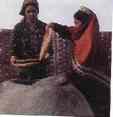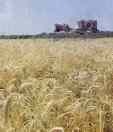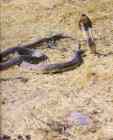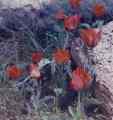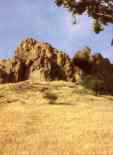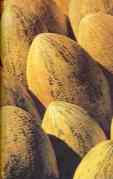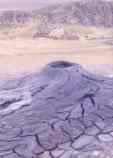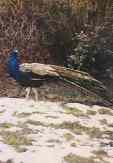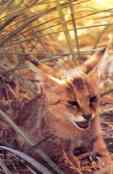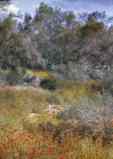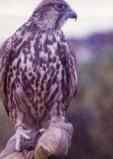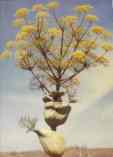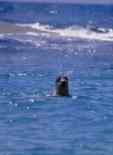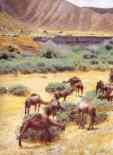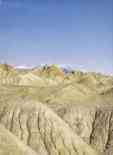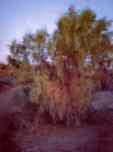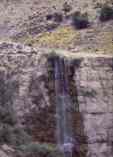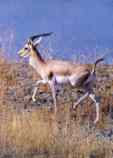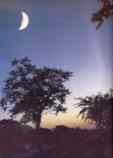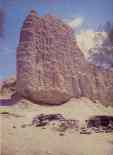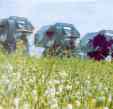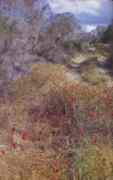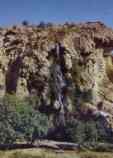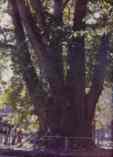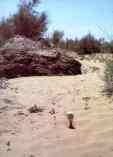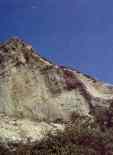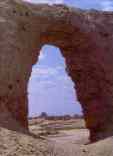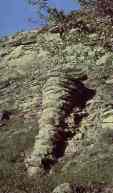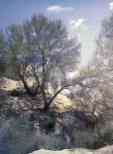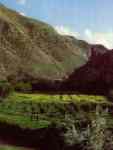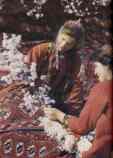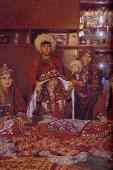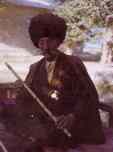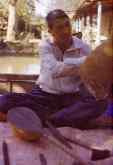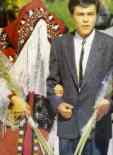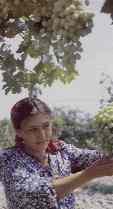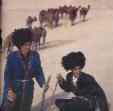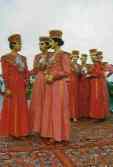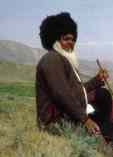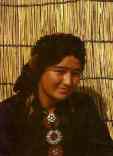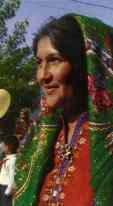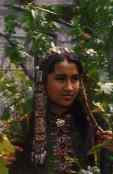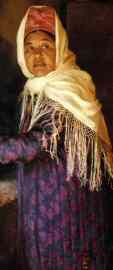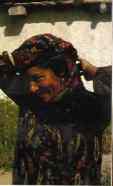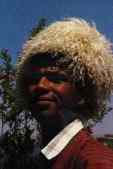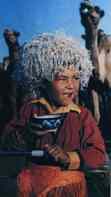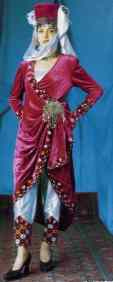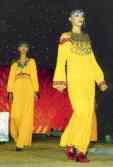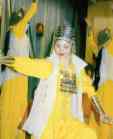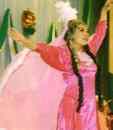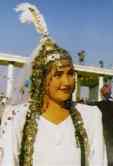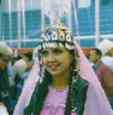|
A V I D E O
C L I P
About Turkmenistan
Watch or Download (7.08 mb)
Another Video Clip About
Turkmenistan
Watch or Download (7.08 mb)
Cities & historical places in Turkmenistan
Abeverd
Anau
Asgabat
Kugitangtau
Kunja_Urgenc
Merv
Nisa
- - - - - - - - - -
Listen to
turkmenistan National Music (with voice)
or
Download
(2.52 mb)
Listen to
turkmenistan National Music (digital, No Voice)
or
Download (2.52
mb)
P H O T O A L B
U M
Turkmenistan came into being following
the expression of the people's will in an October 1991 referendum and the
passage by parliament of the Law of Independence.
It is situated in Central Asia north of
Kopet Dagh Mountains, between the Caspian Sea in the west and Amu Darya in
the east.
Total area: 488,1 sq km. The territory of
Turkmenistan stretches for 1110 kilometres from west to east and 650
kilometres from north to south. Turkmenistan has border in the north with
Kazakhstan, in the east and north-east with Uzbekistan in the south with Iran
and in the south-east with Afghanistan. Population: 4,7 million. Turkmens
constitute 72% of the republic's population, Hi,ussians 10%, Uzbeks 9% and
others 9% . The capital of Turkmenistan is Ashgabat. It is a modern city with
the population of 450.000 peoples.
Turkmenistan is devided into five regions
(velayats). They are: Akhal, Balkan, Dashkhovuz, Lebap, Mary.
The Turkmen language, of the Turkic group,
is the state language of the republic.
Under the Constitution, which was adopted
on May, 18, 1992. Turkmenistan is a democratic, lawbased and secular state,
which wields supreme and full authority on its territory and independently
pursues domestic and foreign policies.
Turkmenistan is an equal subject of the
world community, adheres in foreign policy to the principles of peaceful
coexistence, renunciation of the use of force and noninterference in the
internal affairs of other states, mutually advantageous development of
relations, good neighbourliness, the strengthening of friendship. Being the
member of some large international organizations. It recognizes the priority
of universally accepted rules of international law.
The mineral-raw material, economic
potential of Turkmenistan, relative to its population, is very high and based
on the political and social stability of Turkmenistan and its vast reserves
of natural recources and raw materials.
Nowdays the population of the country works
to fulfil the program of ¨ 10 years of prosperity¯ announced by the President
of Turkmenistan Saparmurat Niyazov. This program is intended to intergrate
Turkmenistan to the world community.
ECONOMY
A nation's policy is essentially an
expression of its economic situation. Major transformations now under way in
the country's economy and society are but an introduction to a qualitatively
new phase of development. Its priorities are set in a three-year program to
be carried out over the 1994-1996 period and to serve as a springboard for
attaining the objectives of the ¨ 10 years of Prosperity¯ policy.
To streamline the efforts to be made, the
following priorities have been established: achieving the nation's real
economic independence, in the first place, selfsufficiency in foodstuffs
supplies; completing structural economic transformation; expediting
advancement in the food and consumer goods industries as a basis for
stabilizing the manat; promoting market-based relations and free enterprise
with the emphasis on encouraging foreign investment. Utmost importance will
be attached to the key sectors, with oil, gas and related processirżg
facilities holding the lead in retooling and expansion. The above measures
are designed to provide enough drive to the whole of Turkmenistan's economy
to achieve the standards projected for the 1994-1996 and 1994-2002 periods.
The program ¨ 10 years of prosperity¯ has
incorporated the previously developed specialized programs known as New
Village, Grain, Education, Processing, and the Concept of the development of
the oil and gas sector over the period to 2020.
Industrial development will be essentially
building on the increasingly extensive use of local hydrocarbons and mineral
resources and also on the accelerated rise of the consumer complex.
According to the Concept of oil and gas
development in Turkmenistan over the period to 2020, oil production
(including gas condensate) will reach the 9 mln ton mark by 1996, 1.8 times
the 1993 level. By 2002, it will be equal to 28 million tons, 5.4 times the
1992 total.
Gas production will rise to 90 billion
cu.m. by 1996, 1.4 times the 1993 output.
By the end of the ten-year period, the
nation will produce 120 billion cu.m. of natural gas, twice as much as at the
start of the program.
In the field of electric energy supplies,
the projected levels of production have been arrived at taking into account
the domestic demand plus considerable amounts of electric power intended for
export. The 1996 total is expected to be equal to 11.6 billion kwh.
To improve access to the country's utility
for outside users, the construction of power lines to Afghanistan, Iran,
Turkey and Pakistan is envisioned.
Turkmenistan's agro-industrial complex will
also be facing the challenge of reform. The next three years are considered
the period of transition to the nation's selfsufficiency in providing itself
with grain and other staple produce. By 2002, full independence from outside
foodstuffs supplies is to be achieved.
The country's best economic interests
suggest that a rise in annual cotton production to 1.6 million tonnes be
ensured by 1996. Over the ten-year period, the yields will grow 1.5 times to
reach the 2 million mark.
The projected period will see a burst of
foreign economic activity, with Turkmenistan aggressively penetrating new
export markets. Exports are expected to amount to $ 6.9 billion in 1996, with
imports equaling $ 3.2 billion. Later on, the trade balance is to rise to $ 5
billion in 2002 from $ 3.7 in 1996, with $ 9.8 billion in exports and $ 4.8
billion in imports at the end of the ten-year period.
Buildings
|
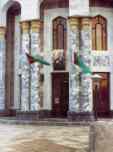
01-
|
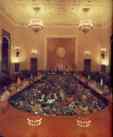
The meeting room of the Council of
Ministers' of Turkmenistan.
02-
|

03-
|

04-
|
|

05-
|

06-
|

07-
|

08-
|
|

09-
|

Ashgabat. The hote "Ak
Altyn-Plaza".
10-
|

Ashgabat. The hotel "Akhal".
11-
|

Ashgabat. The hotel
"Independent"
12-
|
|

Ashgabat. The hotel "Nebitchi".
13-
|

Ashgabat. the hotel "Asia"
14-
|

Ashgabat. The hotel "Akhal".
15-
|

16-
|
|

17-
|
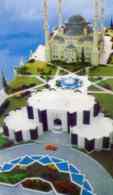
18-
|
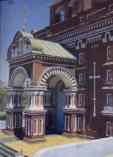
19-
|

20-
|
|

21-
|
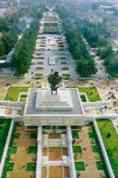
22-
|
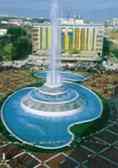
23-
|
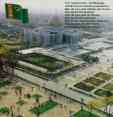
24-
|
|
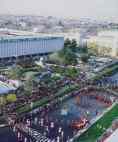
25-
|

26-
|
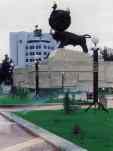
27-
|
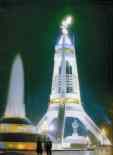
28-
|
|
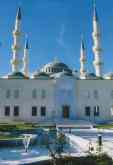
29-
|
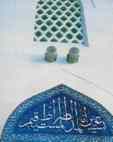
30-
|
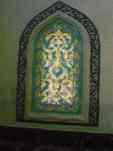
31-
|

32-
|
|
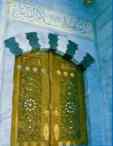
33-
|

34-
|

35-
|

36-
|
|
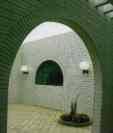
37-
|

38-
|

39-
|
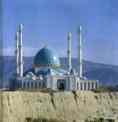
|
FOLKLORE
NATURE
For a person who looks at a map of
Turkmenistan for the first time it presents an uninterrupted desert. It is
not surprising. The substantial part of the total territory of Turkmenistan
is occupied by Karakum sands. Still the first impression is sure to appear to
be false, as not many of the countries can be proud of such a wealth of plant
and animals kingdoms, such a variety of landscapes and climatic zones. The
nature of Turkmenistan is rich in tens of tlżousands of types of flora and
fauna. Many of these types are unique and can be seen only here on the
Turkmen land. The nature of Turkmenistan is also a mighty source of material
resources for the people living here. With every step in the desert one can
feel the mighty breath of life. The nature of sands is not always favourable
to man. But it is the living nature, existing in accorsdance with the laws
that have been laid down for millenia. The conditions of hot dry climate,
caused the development of unique forms of plants able to get at lifegiving
moisture from the great depths, to stand still in its development for the
period of severe whithering summer heat and to bloom wild and unstopable in
the period of short lifegiving spring.
In the common ecological system of desert,
thanks to the sharp biological balanse many representatives of the animal
world feel fine as well. All these representative of the fauna begining from
¨the crokodile of the sands ¯ - varan and ending with ¨the ship of desert¯ -
camel - are unique mainly because they posess the surprising abilixy to
acclimatization to the extreme climatic pecularities.
And skilful and careful handling of life
potential of the desert can also bring substantial profit to man. The desert
ranges only allow grazing of multithousand herds of sheep and camels.
But most brightly and completely the Nature
of Turkmenistan reveals its colourful variety . in those climatic zones,
where there is an abündance of water, the basis of life. Vibrant Mooming of
life rains in the cool foothills, in the river valeys, in the boundaries
between different natural zones.
But even today in the remotest places,
hidden from accidental glances one can come across a porcupine, a ¨red cat¯,
a hyena and even a leopard.
Eight state preserves of Turkcmenistan
cover more than half a million hectares of dry lands and about 200000
hectares of bodies of water. On their territory more than 3000 types of
plants, 50 types of fish and 279 types of animals are under guard. The
forests occupying more than 3 million hectares are also guarded by goverment.
Mountain landscapes are not less
characteristic of Turkmenistan than those of desert. This is not surprising.
In the south, east and west of Turkmenistan there are mountain masses of the
Kopet-Dag, Koyten-Dag, Balkans. If one goes the zigzagging mountain road,
every new turn, every new step presents him with inimmitable beauty of
canyons, slopes of mountains, alpine meadows, clean rivers and waterfalls.
The mountain regions of Turkmenistan is also an invaluable store-house of
mineral resourses.
According to the calculations of scientists
the plant world of Turkmenistan includes more than 2600 types of wild plants.
The animal world of Turkmenistan is represented by not less than 700 types of
vertebrate and 10000 types invertebrate animals. The nature of Turkmenistan
is rich in medicine herbz. 344 types of medicine herbz grow only in the
territory of Turkmenistan.
But not of less value are the unique
healing springs, salty lakes rich in minerals and many other manifestations
of multifarious nature. As for recreational potential Turkmenistan can be
rightfully concidered to be one of the leading in the world.
One cannot khow nature of Turkmenistan not
having visited the Caspian sea-shore. The Caspian sea is the largest in the
world selfcontained salty sea (lake) which has no connection with the world's
oceans. On the territory of the Caspian sea only one can come across
flamingo, pelicans and many other birds who are on the list of endangered
species (the Red Book). Special attention of the nature protection service is
raid to preserving the populations of valuable stuegeon fishes.
Dromedary Camels

These animals are examples of the Arvana
breed of Dromedary camels. This breed was developed in Turkmenistan thousands
of years ago. For the nomadic Turkoman population living in the Kara-Kum
desert the Arvana has been the only animal supplying milk, meat, wool and
transportation for almost a millennia. Rock drawings of one-humped camels,
probably domesticated, have been found in the northwest foothills of the
Sultan-Uizdag in northern Turkmenistan in the settlement of Byash-Tyube which
dates to 3000-1500 BC. Some rock drawings in the Chendir ravine on the
western slopes of the Kopet-Dag in southwest Turkmenistan depict domesticated
dromedaries and riders and date to the beginning of our current era. The
possibility that dromedaries were independently domesticated in Turkmenistan
and in Arabia 5000-600 years ago cannot be excluded.
The Arvana is a typically milk yielding,
pack carrying and smooth riding breed of camels. The present day qualities
have been achived by long selection: special attention was paid to the use of
sires out of high milk yeilding females. Arvanas have the highest milk yield
of all breeds in the world.
Arvana dromedaries are reared in all
parts of Turkmenistan, as well as in Uzbekistan, Azerbaijan and southern
districts of Kazakhstan. They are also found in Turkey, northern Iran and
Afghanistan, where they may have been introduced by the Turkmen migrants in
the 12th century during the conquest of these countries by the Seljuks.
Arvana camels are not adapted to severe
winters. In zones of high humidity they are susceptible to parasitic blood
diseases and helminthasis and are defenseless against bloodsucking insects.

Arvana camels are early maturing. They
reach maturity before the age of two years. The females are mated when they
reach three years of age and have a live weight of 350-400 kg. Males are used
for service from 4-5 to 15-16 years of age. Breeding is restricted to teh
season from January to April. Gestation period is, on average, 385 days and
the females give birth about every two years. Shortening the calving interval
as practised in Turkmenia makes possible two calves in three years.
The live weight of the calves at birth
is 38-40 kg. Their rapid live weight gain is maintained during the firth year
of life, the average daily live-weight gain being 950-1030 g. Weaning is done
at the age of one year.
The lacation period lasts 15-18 months.
Females are milked by hand 2-6 times per day depending on the yeild. Machine
milking is also practiced. For a group of females in the camel breeding farm
Sakar-Chaga average milk yeild was 4387 kg in 18 months, they yeild of the
first calvers being 3117 kg. The average daily yeild of some animal amounted
ot 15 kg, the top yeild being 19 kg. In addition tothe amount needed for
suckling calves, females can give 1718 kg of marketable milk with 4.13% of
fat in a 12 month lactation.
The average wool clip of males is 3.28
kg and that of females 2.10 kg. The fleece wool of adult Arvana camels totals
91.2% of the clip (the rest is threads and tips) and the clean wool yield of
fibers is 78.6%. The local population uses camel wool for production of
natural yarn and knitted wear.
The main advantage of camels as beasts
of burden consists in their ability to traverse deserts and in being cheap
load carriers. In an 8-10 hour working day Arvana camels can carry packs
weighing 200-300 kg for a distance of 30-35 km.
Reference:
Dmitriez, N.G. and
Ernst, L.K. (1989) Animal Genetic Resources of the USSR. Animal Production
and Health Paper Publ. by FAO, Rome, 517
pp.
Human
Archaelogical
(History)
Historians and archeologists consider
sunny Turkmenistan as the home of the most ancient civilizations in the
world. The latest archaelogical discoveries allow one to date the origins of
human society in this area from the 800 thousand years B.C. On that remote
epoch the ancient Amu-Darya river flowed through the vast steppes which now
occupy the modern Kara-Kum desert. It was the home of elephants and noble
deer; thick forests of Archa, covered by nearly Kopet-Dag and KoytenDag
mountains.
Archacological excavations in the
Damdamcheshme I and II grottoes on the slopes of the Big Balkhan Mountains
show that between the Mesolith and Neolith one of the ancient world centres
of the domestication of animals was situated here. It was also a place where
a life of hunting was being replaced by a productive economy.
At this time at the foothills of the
Kopet-Dag Mountains, the ancient cultivating civilizations were being born,
giving to mankind many species of plants. The remains of the Djeitun culture
and the cultures of Annau, Namazga-Depe and Goksury, which became popular
among scientists, tell us of the high development of these civilizations. The
most ancient monumental art of this time was discovered in the Pessedjik-Depe
settlement of the Geokdepe region. Ceramic objects with wonderful ornaments,
styled like carpets, now decorate the exibitions of the largest museums.
These ornaments are the sources of the Modern fine arts of Turkmenistan.
On the Bronze age the ancient city and
state civilizations were being formed in Turkmenistan. The civilizations of
Altyndepe and Namazgadepe in Southern Turkmenistan of Margush in the ancient
delta of the Murgab river, of Khorezm in the delta of the AmuDarya river all
reached their zenith. The monumental Babylonian style temple complex of
zikkurat, the tombs with golden heads of oxen and wolves, the monuments of an
ancient written language have all been excavated at the site of the ancient
city Altyndepe. Excavations in the ancient delta of the Murgab river led to
the discovery of the legendary country of Margush of the Holy Avesta,
Togolok-21, the most ancient zoroastrian temple in the world. Scientists
suppose that the prophet of the first world religion, Zaratushtra, began lżis
preachings in the land of Turkmenistan.
The Golden Age of Turkmen history occurred
when the civilizations of Parthia, Khorezm, Margianna flourished in the land
of Turkmenistan. These civilizations were created by the labour and genius of
the ancient Turkmen people, Dakhs and Massagets, Hircanians and Parthians,
Khorezmians and Margiannians all of whom formed the ethnic foundation of the
modern Turkmen people. As the excavations at the sites of the ancient cities
of Old and New Nisa, Kunya-Urgench and Merv show, the culture of ancient
Turkmenistan had strong influence on tlże development of world history and
made a considerable contribution to the treasury of world culture.
On ancient times Turkmenistan also became a
central part of the Great Silk Road, which connected the civilizaiions of the
East and West. It became intermediary for a dialogue between the mutual
influences among cultures.
The civilization of the Middle ages
depended for their development on the antigue civilizations of Turkmenistan;
Turkmenistan became a centre of world power, the states of Khorezmsharhs (Khorezmian
Kings) and Great Seljuks, in which the consolidation of the ancestors of the
Turkmen people and tribes into one Turkmen ethnos took place.
Turkmens played the main role in the
formation of Seljuk States of Rum in Asia Minor and of the Ottoman Empire
which was formed on its fase. They ruled the political Iife in India in the
epoch of ilie Great Mogols and the Turkmen dynasties of Ak-Goyunly and
GaraGoyunly played an important part in political, social and economic life
of Transcaucasia and of North-West oran.
The Monuments of Merw, the capital of Great
Seljuk State and Kunya-Urgench, the capital of Khorezmian rings, the
mauseleum of Sultan Sandjar and Mukhammed ibn-Zeid, Turabek-Khanum and
Tekesh, and some other creative works of other medievial Turkmen architects
are the masterpieces of the world art.
As a result of black winds of wars and
foreign invasions, the largest of which were the invasions of Chindizkhan,
Timur, neighbouring eastern despotic regimes, Russian Empire, the national
Turkmen State was temporarily lost, a lot of Turkmens migrated to other
countries and now they are scattered over many countries of the Easty from
China to the Mediterranearż Sea. Only during the period of the soviet history
twenty per cent oi Turkmen population emigrated fronż Turkmenistan, thousands
of Turkmens were repressed during the fight against so called ¨Basmachestvo¯
(fighters against the Soviet regime).
That is why 1991, the year of declaration
of Independent Turkmenistan became the turning point of modern Turkmen
history, which opened for the country of the most ancient civilizations the
magistral way to the heights of modern world civilization.
|

01-
|
Koneurgench.
Tekesh tomb (XII th century) and minaret (XIV th century).
|
|

02-
|
Ancient Merv.
Sultan Sanjar's tomb (12th century).
|
|

03-
|
|
|
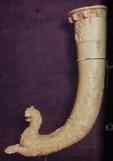
04-
|
Rhytons.Old
Nisa. 2nd-1st centuries B.C.
|
|
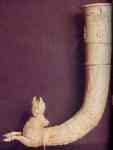
05-
|
Rhytons.Old
Nisa. 2nd-1st centuries B.C.
|
|

06-
|
Ancient Merv. Ibn
Zeyd's tomb (12th century).
|
|
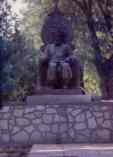
07-
|
Ashgabat.
Monument to Bayram Khan.
|
|
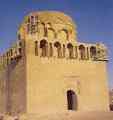
08-
|
|
|
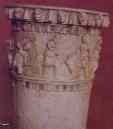
09-
|
Rhytons.Old
Nisa. 2nd-1st centuries B.C.
|
|
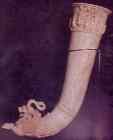
10-
|
Rhytons.Old
Nisa. 2nd-1st centuries B.C.
|
|
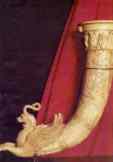
11-
|
Rhytons.Old
Nisa. 2nd-1st centuries B.C.
|
|
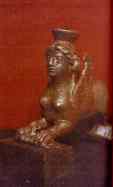
12-
|
|
|
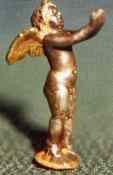
13-
|
|
|
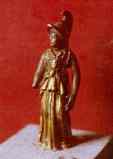
14-
|
|
|
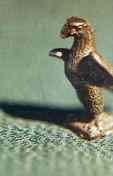
15-
|
|
|
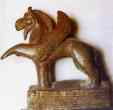
16-
|
|
|
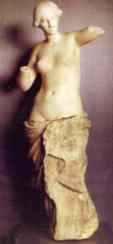
17-
|
|
|
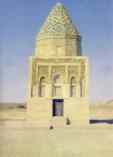
18-
|
Kurneurgench. II
Arslan's tomb (12 century).
|
|

19-
|
Serakhs.
Yarty-gumbez tomb (11th century).
|
|
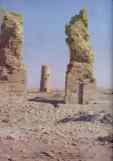
20-
|
Remains of
minaretes and a mosque at the Mostorian town site. (12 th- 13 th
century).
|
|
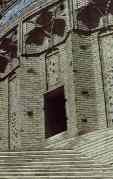
21-
|
|
|

22-
|
|
|
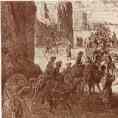
|
Turkmenistan was
always on the crossroads for trade and war routes. The country was an
important part of the Great Silk Road, the symbol of relations between the
West and the East, the most reliable evidence of unprecedented before scale
of international contacts.
|
|

|
Keneurgench. At far
end of Turkmenistan lies Keneurgench City (population 31,400), the State
Historical-Cultural Museum-Reserve of nearly 640 hectares, founded in 1985.
Here one can find several magnificent architectural memorials of the 13-14
century.
|
|
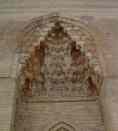
|
Tekesh mausoleum.
Detail of portal
|
|

|
Central portal of
il--Arslan mausoleum
|
|

|
Keneurgench
|
|
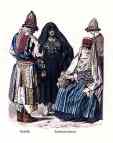
|
THE HISTORY OF COSTUME
By Braun & Schneider - c.1861-1880
Dervish, Turkmen Women
, Late Nineteenth Century - Central Asia
|
fashion!
|












































